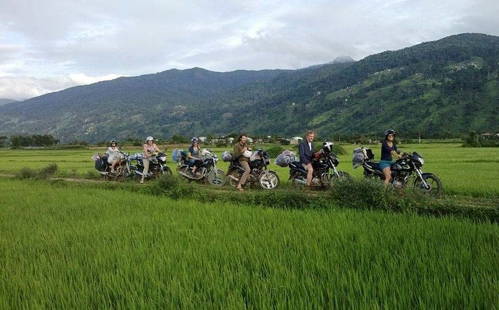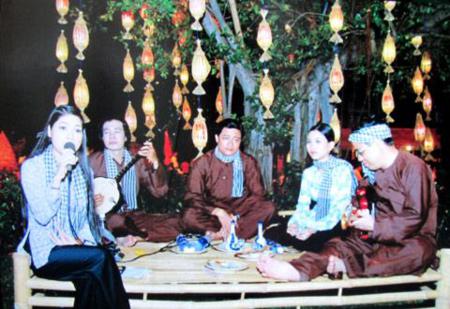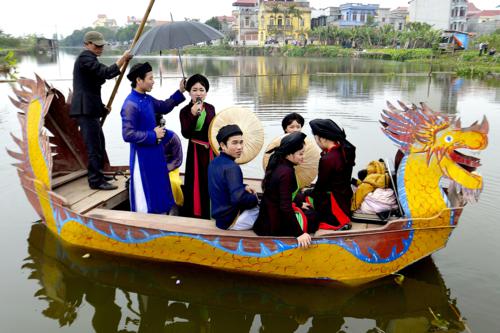Vietnam is ideal for long-distance cycling as much of the country is flat and the shortage of vehicles makes for light traffic. Caution is needed, however, especially on busier roads as traffic can be very undisciplined. Bicycle hire is widely available.
Vietnam, with spectacular mountains, valleys and primal forests, is now considered to be one of the most wonderful places in Southeast Asia for such outdoor adventure activities including trekking and cycling. Moreover, travelling by foot or bicycle will be great choice for anyone who wants to see the country’s beauty and the daily life of local people.

When to go?
- North Vietnam: September to December and April to May
- South Vietnam: November to April next year
Places to go?
For casual cycling, destinations like Da Lat, Hoi An, Hue and Phu Quoc are easy to get around and fun to explore, and renting a bicycle for a day or two is a popular option.
What to bring?
 Bike Clothes:
Bike Clothes:
- Cycling gloves
- Cycling shoes and socks
- Helmet
- Cycling Jerseys
- Padded cycling shorts
- Sun glasses
- Waterproof jacket & pants
When not riding:
- Spare shoes or sandals
- Swimming suit
- Sun hat
- Warm jacket (for mountain area)
Special notes
In Vietnam, keep the right-hand side of the road. Passing from the left side. Watch out before passing vehicles.
For all of these trips, while you can do it on your own, it is recommended to use a tour operator to ensure that you have top-quality equipment, as well as a guide to help you find your way, arrange meals and accommodation, and smooth over language issues in remote areas.
Watersports
In total, Vietnam has 3260km (2021 miles) of coastline. The most popular beaches are Vung Tau, just north of the Mekong Delta; and Nha Trang, near Da Lat, where the clear, turquoise waters offer good snorkeling and scuba diving. Snorkeling and diving equipment can be hired at most beach resorts. Other good beaches can be found in Phan Thiet (south central coast); Mui Ne (noted for its large sand dunes); and the magnificent Ha Long Bay, where some 3000 islands, covered in lush vegetation and dotted with beaches and grottoes, rise out of the Gulf of Tonkin. Access to the islands is by boats, which can be hired in Ha Long City.

Kitesurfing: With beautiful beaches, strong and steady winds, Mui Ne is quickly growing into one of the most popular Kiteboarding and windsurfing sights in Asia. The windy season starts around September/October and lasts until April/May. There are currently four certified Kitesurfing schools in Mui Ne:
- Jibes at Jibes and the Full Moon Resort
- Wind Chimes at the Saigon Mui Ne Resort
Surfing: Most Vietnamese beaches have fairly mild waves. The best place to surf in Vietnam is East Beach, Da Nang, near the North End. There are no waves during the summer, but waves start to pick up from late September/October and may last until May. Vietnam doesn’t have any real surf shops that sell equipment or provide lessons yet, but a board can be rented in Da Nang from Tam’s Pub 43 Ho Xuan Huong street or by asking around in local hotels.
Softer waves suitable for beginners can be found in Mui Ne, Phan Thiet with rentals available around the area.
While the waves may not be world-class, one advantage is that you can have them to yourself!
Kayaking: Kayaking is one of the best ways to explore the beautiful waters and various limestone islands in Ha Long bay. Tours are available from 2 days to 2 weeks, with excellent guide and food. Many tours are a combination of kayaking and trekking, cycling. Kayak rentals and tours are provided by various centers: Marco Polo travel: http://www.kayakingvietnam.com. Recommended reading: Ha Long Bay – Amazing seascapes, caves, kayaking, bio-diversity and Vietnam’s best seafood.
Hiking
There is good hiking and horse riding in the beautiful countryside around Da Lat. Guides are recommended and can be hired locally. Generally, the northwest is the best region for hiking. Other good destinations include Bach Ma National Park, Cuc Phuong National Park (near Hanoi) and Lang Bian Mountain (in Da Lat), where guides are compulsory. In the north, Ba Be Lake National Park (which contains several lakes, waterfalls and caves) and Cat Ba National Park on Cat Ba Island also offer beautiful scenery.
Singing
 “Don Ca Tai Tu”, a kind of music which played by amateur artists is a kind of Vietnamese’s ethnic music which is taken form and developed from the late 19th century. It is the resource of “Nha Nhac Cung Dinh Hue” (the music in Hue Court) and folklore. “Don Ca Tai Tu” is a specific folk art-form in the Southern Vietnam. It is an art in which music is played and sung by Southern commoners and young people after working hours. This kind of music appeared over one hundred years ago and was played with four musical instruments: Dan Nhi (Dan Co) (a sort of vertical violin with two strings), Dan Kim (two chord guitar), Dan Tranh (16-chord zither), Doc Huyen Cam (monochord). “Don Ca Tai Tu” is often performed in the places with charming landscape, especially, when entering the hick waterways, audiences will be heard the smooth singing voice of the Western girls and amateurs captivating their heart in the river. “Don Ca Tai Tu” will impress visitors since the first time of enjoying, because it is the Southern cultural identity in Viet Nam.
“Don Ca Tai Tu”, a kind of music which played by amateur artists is a kind of Vietnamese’s ethnic music which is taken form and developed from the late 19th century. It is the resource of “Nha Nhac Cung Dinh Hue” (the music in Hue Court) and folklore. “Don Ca Tai Tu” is a specific folk art-form in the Southern Vietnam. It is an art in which music is played and sung by Southern commoners and young people after working hours. This kind of music appeared over one hundred years ago and was played with four musical instruments: Dan Nhi (Dan Co) (a sort of vertical violin with two strings), Dan Kim (two chord guitar), Dan Tranh (16-chord zither), Doc Huyen Cam (monochord). “Don Ca Tai Tu” is often performed in the places with charming landscape, especially, when entering the hick waterways, audiences will be heard the smooth singing voice of the Western girls and amateurs captivating their heart in the river. “Don Ca Tai Tu” will impress visitors since the first time of enjoying, because it is the Southern cultural identity in Viet Nam.
Moreover, when arriving at Western Waterways, tourists can not only enjoy “ Don Ca Tai Tu”, but also hear “ Vong Co” which originated from “ Cai Luong” (Reformist) – a kind of old music.. “Vong Co” songs often manifest humans’ feeling and thought such as happiness, sadness, ridicule, fun, etc. All moods are expressed in each word of the song.
“Tu la tu phu tuong
Bao kiem sac phong len dang
Vao ra luong trong tin chang
Nam canh mo mang
Em luong trong tin chang
Oi gan vang quan dau i…o..”
That is confidence of a woman who is waiting for news form her husband who has been joining in the army but has not returned yet.
In addition to, visiting Mekong River Delta and sailing boat on the river or canals, tourists can hear a velvety voice of a young man and woman in “Ho Nam Bo” which is the repartee between males and females. Ho Nam Bo is like a spiritual meal of people in the South Viet Nam.
Festival
 A festival is an event usually celebrated by a local community. It displays the unique and typical characteristic of that community. Most of the communities all over the world celebrate festivals and so does the Khmer ethnic group. This community has a lot of festivals such as Chol Chnam Thmay, Okombok and Dotal. Among them, Chol Chnam Thmay is the most popular Khmer festival.
A festival is an event usually celebrated by a local community. It displays the unique and typical characteristic of that community. Most of the communities all over the world celebrate festivals and so does the Khmer ethnic group. This community has a lot of festivals such as Chol Chnam Thmay, Okombok and Dotal. Among them, Chol Chnam Thmay is the most popular Khmer festival.
Chol Chnam Thmay is the most important festival among the traditional festivals of Khmer people in the Mekong Delta River. At the beginning of the Chet month (in Buddhist calendar), Chol Chnam Thmay is celebrated. It lasts three days, and four days in leap year. There are three official days; each of these days has its own name. The first day is named as Moha Sangkran (lễ rước Đại Lich) or Chol Sangkran Thmay. The next day is called Wanabat or Wonbof (lễ dâng cơm và đắp núi cát). Tonga Laeung Saka or Lomsak is the third and usually the last day of the festival. On these days, people come to visit their relatives, their friends and their neighbors, giving them the best wishes and good lucks. They also take part in numerous activities in the festival. Sometimes the festival lasts longer and it takes people almost a week to turn back to their everyday life.
Cooking Class
Vietnam has finally got more of the recognition it deserves in the world for its cuisine, with fresh ingredients and imaginative flavors, and one of the highlights of any trip to Vietnam is the food. Even if you do not expect to do much Vietnamese cooking, a cooking class is a fun and interesting way to learn about the local ingredients and how to make some of the popular dishes.

In general, most cooking classes are half-day classes starting with in the morning with a trip to the local market followed by a cooking demonstration and lunch where you can eat the dishes that were prepared.
Most of the classes tend to be aimed at casual tourists, rather than serious chefs, and many tend to be cooking demonstrations, rather than classes with individual cooking stations. Please inquire before you book. Also, please keep in mind that some of the smaller, ad-hoc programs may be more flexible to change the menu or request more interaction, especially if you arrange your own private lesson for your group.
You can join a cooking class in Hanoi, Hue, Hoi An, Ho Chi Minh, Nha Trang…
